Can charging supply keep pace with electric vehicle demand?
Net-zero carbon emissions by 2050…
Electric vehicles (EVs) are increasingly heralded by nations across the globe as a vital part of the net-zero transition to reduce emissions, and the key technology for decarbonising transportation, which accounts for 13% of emissions globally. But whilst vehicle sales have been booming in recent years, the installation of charging networks that underpin EV usage are trailing dangerously behind. The extent of this lag is particularly concerning in the United Kingdom (UK) where it poses a fundamental threat not just to the continued growth of the EV market, which by the end of 2023 is projected to be worth £16bn, but it threatens any plans for the UK to reach net zero carbon emissions by 2050.
A global EV boom driven by three central influences
Such has been the drive to increase the uptake of EVs, that global sales of Battery EVs (BEVs) and Plug-In Hybrid EVs (PHEV) doubled in 2021 from the previous year, and 2022 saw a +55% increase in global EV sales over ‘21. The registration of 10.5 million new vehicles in ’22 was despite component supply chain shortages and disruptions from the war in Ukraine that hampered output. With approximately 27 million EVs on the road today, they now account for a global market share of 13% of vehicles on the road.
What is clear is that as global consumers increasingly align their climate-driven values with vehicle purchasing, the number of EVs on the road will continue to rise exponentially. This is an ‘EV boom’ that has been accelerated by a combination of three central influences:
- Sustained governmental policy support, in the form of subsidies and incentives, pledges to phase out internal combustion engines (ICEs), and lofty electrification targets
- The rise in the availability and performance of EV models, which now gives consumers five times as many to choose from than in 2015
- Electrification of fleets by car manufacturers, in a race to meet rising consumer demand.

Showcasing the innovations and ideas behind EV market growth
The annual London EV show and conference, held at the end of November ‘22, is a platform where stakeholders from all three market influences gather to showcase the innovations and ideas that are spearheading the UK EV transition. With representation from the entire value chain, this year’s event included collaborations between government representatives, fleet management, charging systems & solutions providers, battery technology providers, major car manufacturers, and other influential stakeholders.
Attending the show provided me with a ‘peak-under-the-bonnet’ of the UK EV market and shed light on some of the key trends emerging in 2023 and beyond. Conference talks included those from industry leaders and leading research centres, amongst the latest vehicle innovations being showcased. These talks had one key common theme – that whilst a marketplace as dynamic as EVs offers great opportunity, commercially and in tackling climate change, capitalising effectively on these opportunities over the next few years will be fraught with challenge for the UK.
UK charging infrastructure is struggling to keep pace with the EV growth
The London EV show highlighted just how much the UK EV market has expanded in recent years in line with global growth, notching up an impressive 92% increase in EV registrations between January ‘21 and January ‘22.
UK charging, however, is still in its infancy relative to the vehicles it powers, and comparatively lags behind. There is a growing disparity between the growth rates of EV sales in the UK and charge point installations. This divergence threatens to impede the UK from meeting climate-goals set by the government and derail the feasibility of the UK’s ban on internal combustion engines (ICEs) that looms in 2030.

When you compare the absolute number of public charge point installations the UK needs to support the proposed transition, with current figures, it is clear there is still a long way to go. If the government’s 2022 charging infrastructure strategy successfully meets its ambition, by 2030 there should be over 300,000 public chargers installed nationwide. In comparison, as of January ‘23, there were cumulatively just 38,000 public charge points available across the UK.
More importantly, though, is considering the pace of charger installations relative to new EV registrations – which is slowing owing to the continued acceleration of new EV registrations. Since January ‘20, the cumulative number of EVs in the UK has increased 3.8X, whereas the number of charge points has increased just 2.6X. This increasing disparity is made ever clearer by the change in the UK’s EV-to-charge point ratio – a measure which helps assess the suitability of a nation’s charging network to support its vehicle’s needs.
As a benchmark, the Alternative Fuel Infrastructure Directive (AFID), an EU policy which regulates the deployment of public chargers, recommends a ratio of 10 EVs per public charge point for EU member states.
In 2016, the UK had a healthy ratio of approximately 8 EVs per charge point. Comparatively, the UK now has the 9th worst global ratio of 21 EVs per public charge point. There are evidently key lessons to be learned from the likes of South Korea, the global leader which boasts a ratio of just 2.6.
Unlocking mass adoption with public charging infrastructure
The vehicle-to-charger gap poses a fundamental problem to the mass adoption of EVs in the UK, for two main reasons. Firstly, on average, 30% of UK households lack off-street parking for residential charging. This figure rises to around 40% across major UK cities, and as high as 50% in London. These households will therefore have to rely on the public charging network – either off-street slow, charging, or nearby fast/rapid charging hubs – to charge their vehicles at home.
This scenario works, provided there are enough charge points to accommodate users. However, too few chargers pose a major barrier for drivers switching over from ICEs, who will view EVs as impractical until there is somewhere suitably convenient to charge them.
When Which? surveyed 1.5k electric car owners, nearly half said that their nearest public chargers were over a 20-minute walk away.
Not exactly convenient.

The logic is the same looking across the UK’s charging network for longer journeys. For true mass adoption, there needs to be enough charge points to make charging your vehicle battery as convenient as filling up with fuel currently.
Speak to any EV owner in the UK, however, and they will tell you of the growing issues around public charging: long queues, a myriad of payment systems and apps to contend with for different charge-point-operators, and chargers which simply don’t work (experienced by 4 in 10 customers of public EV chargers).
This is not conducive to convincing the masses to switch from ICE vehicles to the more sustainable option of electric.
These issues with the charging infrastructure will continue to exacerbate as drivers become increasingly reliant on public chargers, versus at home or work, the more that make the switch to EVs. The UK urgently needs to accelerate its plans for large-scale installations across the public charging network, which is so far failing to deliver the c.100 installations per day needed until 2030 – last month (Jan ’23) just 28 charging devices were installed per day. A large-scale programme such as this requires a unified drive from all stakeholders.
As demand and supply continue to fall out of balance, this situation presents opportunities for private investment in the expansion of the charging networks. The current EV charge point operator market is highly fragmented and lacks a ‘gold-standard’ of consumer vehicle charging. There is a clear market need that so far appears unfulfilled in both availability and quality.
Whilst there are a multitude of other challenges that must be addressed, such as ensuring a sufficient supply of electricity to meet charging demands, each of these challenges offers their own commercial opportunities.
For those considering entering or expanding within the space, now is the time to answer the key strategic questions – what is the ‘Size of the Prize’ available? Which of the current barriers-to-adoption offer the greatest opportunities if addressed effectively, and how can that value be harnessed?
Milo Eadie
Milo is a strategist and transformation consultant with experience across capital projects, electric vehicle fleets and charging infrastructure, and product development. He began his career as a design engineer in the nuclear industry, where he consulted on the UK's fleet of reactors.
His expertise includes business strategy, data-driven decision making, productivity optimisation, and applied innovation and implementation. He is passionate about combining these skills to support clients in achieving their Net-Zero ambitions.
Milo is a Master of Engineering (MEng, Hons) from the UK’s leading General Engineering course at the University of Bristol, where he gained specialisms in Sustainability, Project Management and Entrepreneurship.
CONTACT US TO FIND OUT HOW WE CAN HELP
Recessions are easy to forecast, so how can CEOs better prepare to weather the economic storm?
‘A rising tide lifts all boats’ is an aphorism associated with the idea that good CEOs can drive business growth during the good times. However, in my experience…
exceptional CEOs drive remarkable growth during economic downturns!
No matter what anyone tells you, recessions are easy to forecast. It’s the severity of the recession that is difficult to predict. One of the most watched charts in economics is the 10-year US treasury interest rates minus the 2-year US treasury interest rates (a.k.a. Yield Curve chart), which has a near-perfect record of forecasting recessions. The yield chart is currently flashing a ‘code red’ highlighting a recession is highly likely within the next 12-18 months. However, it is not all doom and gloom!
Smart CEOs can leverage the yield curve date to ensure their businesses are fortified to weather the upcoming economic storm. As shown on the chart, building financial and operational resistance should be a key priority of executives whilst the yield curve remains inverted!
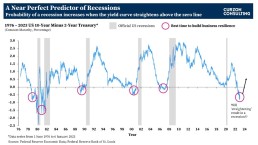
What is yield curve inversion, and why does it matter?
To simplify… the chart shows the 10-year US treasury interest rates minus the 2-year US treasury interest rates. In a normally functioning economy, the longer the bond maturity, the higher the interest rate (yield) demanded by investors. Investors seek higher returns on longer maturing binds as risks become more difficult to anticipate the longer the term extends into the future.
However, when investors are worried about the economy, they get concerned with the ‘here and now’. Therefore, investors demand higher interest rates on short-term maturities; hence, an inversion between the 10-year and the 2-year interest rates takes place.
An inversion occurs when the 10-year US treasury interest rate minus the 2-year US treasury interest rate falls below zero.
Pre-1990s, recessions were recorded whilst the yield curves were inverted (i.e. below the zero line). Post-1990s, all recessions were recorded after the yield curves straightened (post the initial inversion).
As of 6th January 2023, the yield inverted at -0.69. This inversion is flashing a major warning signal! If history repeats again, there is likely to be a recession once the yield curve straightens again.
The question is… how deep will the recession be? That’s hard to forecast, but the current inversion rate is much deeper than what we’ve post-1990. If the inversion continues to deepen similar to the early 1980s, we could potentially see a large recession following.
So what?
As highlighted on the chart, the best time to start a business transformation programme and build financial and operational resilience is when the yield curve is inverted and well BEFORE it straightens again (i.e. rises above the zero line).
CEOs and CFOs should utilise the yield curve chart to kick start or accelerate an existing business transformation programme, well before a recession arrives.
If you are interested in learning more, please get in touch
CONTACT US TO FIND OUT HOW WE CAN HELP
Sustainable Construction Innovation, Does it matter?
The transport construction industry has significant opportunities to reduce carbon by developing materials with lower embedded carbon. Producing cement uses a great deal of energy, so finding a waste product that can substitute for cement makes good environmental sense, while concrete is always at the top of construction sites carbon emissions. Pulverised Fuel Ash, PFA, is a by-product of coal-burning power stations. The ‘ash’ is recovered from the gases and used, amongst other functions, as a cement substitute. This will reduce CO2 by reducing cement through the increased use of cement replacement and increased use of recycled aggregate.
This positive change is one of the most common ways that businesses innovate, and one used to innovate frequently. Cement product innovations play a significant role in the transition towards carbon net-zero emissions across construction industries.
The network of universities, cCatapults, and grant funding allows businesses to embrace innovation and provide more high-value services that change the industry’s innovation capability. There is unprecedented investment and attention by Government, customers and business to advance innovation capability to deliver new business outcomes that will redefine collaborative relationships across the supply chain, increase repeat business with customers and demonstrate that the industry is not a commodity and cannot be procured solely on price. What is delivered is complex and requires highly skilled people to look at delivering the best solution.
Please contact andrew.wilson@curzonconsulting.com or take a look at Curzon Consulting’s sustainability website
References:
GreenSpec. Building Design.

About the author

Andrew Wilson
Andrew is a seasoned strategy and transformation consultant with experience across Africa and the UK.
His background is in capital projects, energy, mining and sustainability. He has a passion for the crossover between productivity, growth and sustainability, complemented by his qualification from Cambridge University in Business and Climate Change: Towards Net Zero Emissions.
Andrew has built mines, towns, roads and power plants, and he aims to keep building using a sustainability lens.
Which risks are the most challenging to carbon net-zero in Africa?
There is a ‘ ticking timebomb’ in third-world countries where there is heavy reliance on fossil fuels (coal burning) for electricity and is responsible for between thirty to/forty per cent of employment. In the particular case of Africa, tThe continent is embarking on a massive expansion of fossil fuel electricity. More than 200 new power stations are planned, the majority of which will burn coal (Pollutionwatch, The Guardian). However, Africa is uniquely positioned to leapfrog dependence on fossil fuels and utilise abundant renewable resources such as solar and wind. Government legislation to reduce this dependency would see joblessness leading to hunger, civil unrest and a potential change of government at the ballot box. Trade Unions are very strong in these sectors due to human rights abuses for tens of years. For change to happen, there is a tricky hierarchy of political players to be satisfied and included before any legislation would be agreed and implemented.
What business opportunities could be related to the African net-zero transition?
Many of the countries mentioned above have very high temperatures, which provide strong sunlight. This raises solar panel opportunities. The countries are also vast and tempting medium-term investment options for wind turbines as their manufacturing costs drop and returns increase as populations grow and require electrification. Fossil fuel companies need to start investing in renewable energies to continue making positive revenue margins and balancing their emissions to carbon net-zero.
Social or economic network effects?
There are extreme views against fossil fuel companies, often with headquarters in European countries. Social media highlights these emission concerns and provides a platform to disseminate important emission information and gather people to attend anti-emissions rallies.
Contact me at www.curzonconsulting.com to discuss further.
About the author

Andrew Wilson
Andrew is a seasoned strategy and transformation consultant with experience across Africa and the UK.
His background is in capital projects, energy, mining and sustainability. He has a passion for the crossover between productivity, growth and sustainability, complemented by his qualification from Cambridge University in Business and Climate Change: Towards Net Zero Emissions.
Andrew has built mines, towns, roads and power plants, and he aims to keep building using a sustainability lens.
Why renewable energy is fuelling investor interest?
Renewables will represent 80% of the total share of investments in power generating capacity from today to 2050. Global energy needs are expected to grow by 30% between today and 2040.
As an asset class, renewable energy has matured dramatically over the past two decades. It has gone from being seen as an alternative culture to having huge investment potential. At the same time, traditional investment norms are changing and not just because of the evolving sustainability mega-trend. In recent years, investment managers have increased their allocations to the broader real assets sector with growing numbers classifying infrastructure and real estate as “real assets”.
Solar power does not pollute the air with greenhouse gases and is noise-free to be used for residential purposes. Solar opportunities are available at various scales, i.e. for households and large business ventures providing power to the grid. Solar panels are the fastest-growing renewable energy option, thanks to falling costs and increasing investment. Their easy installation and “low emissions” are environmentally friendly.
Wind turbine power will be an increasingly compelling longer-term investment due to increasing urbanisation and population growth, leading to higher electricity demand. Technological progress with relative cost advantages for renewable energies and an improved regulatory environment (social and political support) motivates businesses to manufacture wind turbines.

About the author

Andrew Wilson
Andrew is a seasoned strategy and transformation consultant with experience across Africa and the UK.
His background is in capital projects, energy, mining and sustainability. He has a passion for the crossover between productivity, growth and sustainability, complemented by his qualification from Cambridge University in Business and Climate Change: Towards Net Zero Emissions.
Andrew has built mines, towns, roads and power plants, and he aims to keep building using a sustainability lens.
Why Coupling your Business Plan With Your Decarbonisation Plan is More Effective Than Drafting Them Separately?
There are incredible synergies with aligning purpose and ambition in the decarbonisation sense to the Mission, Vision and Values of the business. Thinking of them in unison will intertwine the business plan (revenue generation) with the decarbonisation plan and allow the business to set short and long-term business goals and decarbonisation metrics. As with most strategy plans, the goals/metrics should be reviewed bi-annually to correct any deviations from the plan.
In the government highway infrastructure sector, the business is aligned to decarbonisation 2050 as legislated by the Paris Agreement 2015 with 2030, 2040 and 2050 time horizons to achieve scientifically based metrics. Collaboration with delivery partners is crucial in reaching these targets. Targets for the delivery partners are aligned to ensuring achieving the business’s Scope 1,2 and 3 targets.
Innovation and collaboration are driving decarbonised materials, electric fleets and whole life design thinking. In other words, it directs a circular economy. Proven technologies and close ties to the government encourage policymakers to be bolder with the legislation they advise politicians to implement. With proven technologies being implemented, financiers are more willing to provide financing.
These innovations provide people who live around major highways with cleaner air and reduced pollution. Less pollution means fewer lung inflictions which ultimately means a healthier society and reduced pressure on the NHS.

About the author

Andrew Wilson
Andrew is a seasoned strategy and transformation consultant with experience across Africa and the UK.
His background is in capital projects, energy, mining and sustainability. He has a passion for the crossover between productivity, growth and sustainability, complemented by his qualification from Cambridge University in Business and Climate Change: Towards Net Zero Emissions.
Andrew has built mines, towns, roads and power plants, and he aims to keep building using a sustainability lens.
Is Degrowth and Decoupling The Answer to Sustainability?
There is little evidence that greenhouse gas emissions can be decoupled from economic growth in absolute terms from an environmental perspective. Since economic growth is one of the main drivers for rising emissions (and increasing depletion of non-renewable resources), it seems evident that a transition to degrowth would make an essential contribution to climate change mitigation, and hence to our moral obligation to preserve future generations’ rights to basic needs fulfilment.
GDP ultimately cannot be decoupled from material and energy use growth. It is, therefore, misleading to develop a growth-oriented policy around the expectation that decoupling is possible. We also note that GDP is increasingly seen as a poor substitution for societal wellbeing. GDP growth is, therefore, a questionable societal goal. Society can sustainably improve wellbeing, including the wellbeing of its natural assets, but only by discarding GDP growth as the goal favouring more comprehensive measures of societal wellbeing.
While relative decoupling has been observed in multiple countries, absolute decoupling remains elusive. Studies observe that no country has achieved absolute decoupling during the past 50 years. Another study reports that population growth and increases in affluence are overwhelming efficiency improvements at the global scale. There is no evidence for absolute reductions in environmental impacts and little evidence to date, even for significant relative decoupling.
Technological advances can lead to absolute decoupling for specific types of impact. For example, it is possible to envisage a scenario in which GDP growth is decoupled from using fossil fuels and related CO2 emissions by switching to 100% renewable energy.
References:
Plos one. Is Decoupling GDP Growth from Environmental Impact Possible?

About the author

Andrew Wilson
Andrew is a seasoned strategy and transformation consultant with experience across Africa and the UK.
His background is in capital projects, energy, mining and sustainability. He has a passion for the crossover between productivity, growth and sustainability, complemented by his qualification from Cambridge University in Business and Climate Change: Towards Net Zero Emissions.
Andrew has built mines, towns, roads and power plants, and he aims to keep building using a sustainability lens.
Hip & knee implant manufacturers – The value creation opportunity
If hip and knee implant manufacturers want to stay relevant, and “move the needle” on value creation, they need to play big or go home!
An aging (ageing) population is driving absolute sales, but over the past few years, primary hip and knee procedures have become commoditised, which has resulted in margins being squeezed for both hospital providers and implant manufacturers.
Implant manufacturers have an opportunity to transform their business model, away from traditional “box shifting” product selling (driven by monthly sales targets) to a high value add, high margin managed service proposition, where multi-year partnerships are formed with hospital providers. Implant manufacturers need to provide additional services along the value chain, especially as health systems move towards value-based care models.
The Value Creation Opportunity
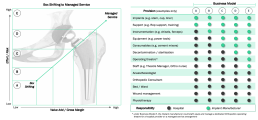
About the author
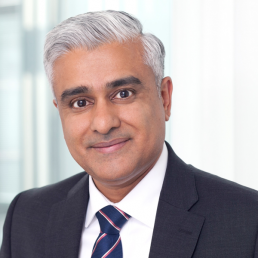
Chetan Trivedi
I lead Healthcare at Curzon Consulting.
For over 15 years I have supported Healthcare payers, providers and medical devices companies on strategy, operational improvement and digital transformation engagements across the UK, wider Europe, Middle East, US, India and Canada.
I am deeply passionate about improving health outcomes, safety and quality of life for patients.
CONTACT US TO FIND OUT HOW WE CAN HELP
Why renewable energy is fuelling investor interest
As an asset class, renewable energy has matured dramatically over the past two decades. It has gone from being seen as an alternative culture to having huge investment potential. At the same time, traditional investment norms are changing and not just because of the evolving sustainability mega-trend. In recent years, investment managers have increased their allocations to the broader real assets sector with growing numbers classifying infrastructure and real estate as “real assets”.
Solar power does not pollute the air with greenhouse gases and is noise-free to be used for residential purposes. Solar opportunities are available at various scales, i.e. for households and large business ventures providing power to the grid. Solar panels are the fastest-growing renewable energy option, thanks to falling costs and increasing investment. Their easy installation and “low emissions” are environmentally friendly.
Wind turbine power will be an increasingly compelling longer-term investment due to increasing urbanisation and population growth, leading to higher electricity demand. Technological progress with relative cost advantages for renewable energies and an improved regulatory environment (social and political support) motivates businesses to manufacture wind turbines.
Get in touch with Andrew to discuss
CONTACT US TO FIND OUT HOW WE CAN HELP
Sign up to our insights
The Future of Work in Financial Services
The last 15 months had seismic impacts on workforces and ways of working
Banks and insurers weren’t prepared for the pandemic – within days nearly every employee was working from home, all of the time. The initial response was crisis-mode transferral of existing activities, processes and tools to remote – with minimal adaptation.
Most organisations surprised themselves at how quickly this was achieved and asked why they couldn’t make change happen as fast outside of a crisis.
Rises in workforce productivity were reported (less evidenced), but this was partly driven by fear of job loss.
Homeworking conditions varied enormously, with many people dealing with cramped, noisy environments, unreliable internet connectivity, and competing childcare and work demands
Protracted home-working suited some but caused a widespread decline in mental and physical wellbeing for others*, particularly in larger households:
- 46% taking less exercise and 39% developing musculoskeletal problems
- 59% finding it harder to switch off from work and 37% reporting disturbed sleep
- 67% feeling less connected to or isolated from colleagues
- 41% of those living in households with 3+ people think working from home is worse for their health and wellbeing, vs 29% of those living on their own and 24% of those living with just their partner
Business leaders had to respond to a wave of 'here & now' imperatives
How to:
- Immediately ensure operational resilience and prioritise access for those who most needed service
- Adapt and mobilise rapidly to deliver Government-backed support scheme (BBLS, CBILS)
- Avoid customer resentment or loss as a consequence of exceptional service constraints – e.g. motor and health insurers compensating policyholders for reduced need to claim or ability to fulfil claims
- Best minimised disruption and restore service quality for all partners and customers
- Accelerate process and service digitisation to enable all this, e.g. increased chatbot use to manage contact demand
- Provision to manage significant financial risk, e.g. bad loans for banks and increased claims volumes for Life insurers
- Minimise furlough and redundancies and keep colleague morale and motivation high
- Ensure a safe, confident return to the workplace during those periods when permitted/required to
Expansive, strategic initiatives – like progress on sustainability, operating model and core technology change – were largely relegated down the agenda
Today’s focus is on transitioning to new ways of working which will best advantage organisations and colleagues after restrictions end
- The Government requirement to work from home whenever possible lifts on July 19th
- Though uncertainty continues with some senior scientific advisers urging continued working from home over the summer
- Return to the workplace is underway within Financial Services albeit under varying conditions, speeds and guidance
- Lots has been done on scenarios and plans for what the new ways of working will look like, and how they will be better…
But how ready are banks and insurers to execute their plans and take full advantage of the many opportunities the transition offers?
Visions of the Future of Work vary, and the best solution to many implementation complexities is not yet known
Simplistically, strategies divide between three broad options
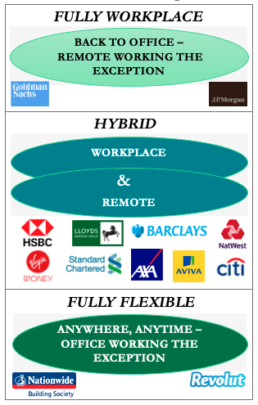
But one size won’t fit all
There are multiple work ‘personae’ with different required and desired ways of working:
- e.g. in the wealth management division of a bank, traders may be encouraged back to the office full time…
- where, Ops and Technology colleagues shift to a 1:3:1 week [1 day in the office, 3 at home, 1 flexible]
- while private banking account managers go to fully flexible
Many questions still need working through before the optimised hybrid model is found such as:
- What will the office be used for on return – which tasks and activities need to be conducted there and what changes in office design/functionality will best support those?
- What and how should policies flex to deal with exceptions, e.g. for people with lower comfort levels about returning to office-based or more cautious views of ongoing Covid risks?
- Where and how should front/middle/back-office processes and controls differ between the office and home?
- Where and why should this prompt a reshuffle of roles, interfaces, activities to maximise performance?
- Do certain roles no longer need to be attached to a site/location? E.g. could a UK job be done 100% from home in France?
- How to ensure similarity between home and office experience where it matters to avoid some colleagues feeling disconnected, and to bolster inclusivity?
- To what extent will savings from reduced office space outweigh costs of standardising/upgrading home working equipment, furniture, and technology?
The challenge is now to successfully translate the vision into the new operating and cultural reality… and deliver maximum benefit from it
The Future of Work challenge facing organisations now is how to actually ‘make it happen’
Moving to action is the hard part, and in our view, the effort needs two strongly coordinated legs:
- Piloting the practical changes needed to establish and embed target new ways of working – testing/learning and refining at pace to best effect across the entire business, attuned to the needs of different work personae
- Designing and delivering deeper change that goes beyond just re-configuring office space – to create maximum value by converting the breadth and depth of opportunities opened up by the FoW, so…
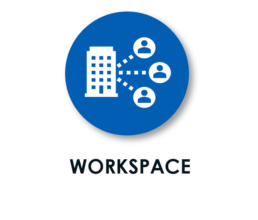
- Optimise and flex office access and space in synch with hybrid working needs
- Perfect the work-at-home equipped-ness and experience
- Convert cost-savings from real estate footprint and usage reduction
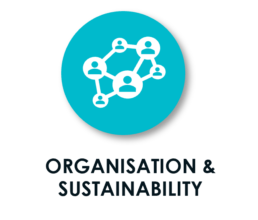
- Organise across functions and silos for hybrid working effectiveness
- Link WoW changes to delivery of CN0 & cost optimisation goals
- Raise employee engagement as a purpose-based organisation
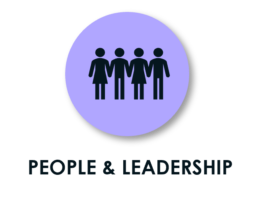
- Improve management, coaching, motivational techniques and controls to bridge in/out office split
- Skills & behaviours ‘upgrade’ for higher performance and positive culture change
- Enrich diversity and recruit the best talent from a wider geography
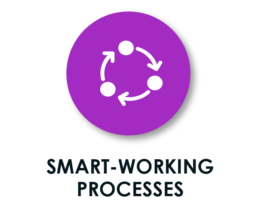
- Re-think routine activities for maximum efficiency
- Introduce smarter working processes to boost productivity
- Drive those pandemic customer behaviours (like increased digital payments) which boost productivity and enhance CX
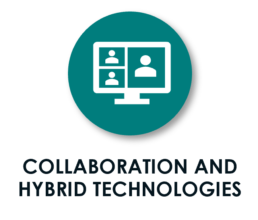
- Adopt best collaboration tools and AI/automation technology to improve work quality, pace, output
- Clear out under-utilised or no longer fit for purpose office collaboration / workflow tools
In delivering holistic change there is a golden opportunity to redefine the employee value proposition and enhance culture
Holistic change approach to the Future of Work
Designing to most compelling EVP for the future
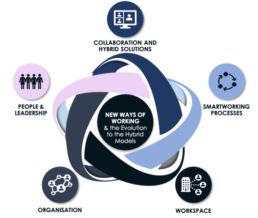
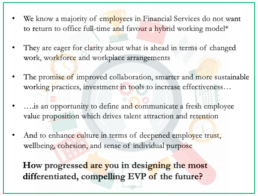
The human and commercial benefits of getting this right are BIG
Banking and insurance have amongst the highest remote working potential of any sector, with around three-quarters of time spent on activities that can be conducted remotely, without the loss of productivity*
Indicate scale benefits of transitioning to 50% remote working are £10M annual savings per 1,000 employees

There are important human capital and reputational /social responsibility benefits to derive from improved employee experience and accelerated reduction in the organisation’s carbon footprint***
* Source McKinsey / What’s Next for Remote Working
** Source Global Workplace Analytics, Amazon, SHRM, Deloitte – average annual savings include the cost of office rent, electricity, water, insurance supplies. Savings based on full-time employees with compatible jobs telecommuting 20 hrs/wk. Assumes 2,000 hour work year and £70/hr labour rate
*** Source Carbon Trust / Homeworking
So… the questions we think you need to be able to answer are…
Strategy
Does your FoW vision and ambition reach far enough?
Is your FoW strategy holistic and clear on what benefits the new ways of working should deliver, in terms of
- human capital
- culture change
- productivity
- operational efficiency
- customer experience
- cost optimisation
- carbon reduction
How robust is the supporting business case and rationale?
Change Design
Do change designs have the necessary sensitivity and granularity at policy, process, controls and performance management levels? Do they have
- defined rules and variability on when in-person presence is required by specific roles, activity mixes and situations
- mitigations of risk of accentuating inequalities and creating new psychological or emotional stresses amongst employees
Test – Learn – Optimise
What will it take to pilot, refine and embed the transition effort successfully and at pace?
Enablement
What needs to be achieved to ensure the organisation and people are ready to adopt the new ways of working?
Have you identified/selected the optimal system, technology and data solutions to enable the hybrid working model?
Benefit Capture
To what degree can you be confident you have the right implementation plans, measures and capabilities to realise the target model and benefits?
We would welcome a discussion to understand where you are in moving from visioning to delivering FoW and which questions matter most to you, and to explore where Curzon’s capabilities may be relevant to your needs






























